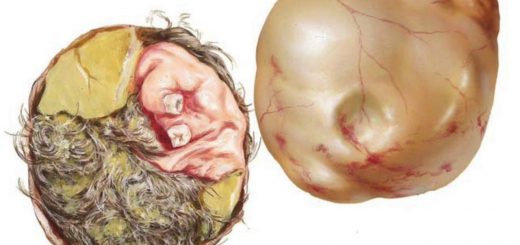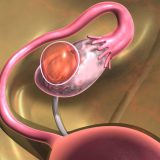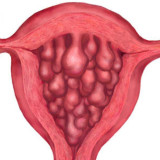Dermoid cyst is a cavity filled with human tissues of different kind, like teeth, skin and hair. Read more information about what cyst is, its causes and main danger here (the link is duplicated below). Or keep reading this page to know about dermoid cyst diagnosis.
Dermoid cyst symptoms that helps diagnosis
This kind of cyst is asymptomatic as many others. It doesn’t manifestates until reaches a size of more than 2,8 inches (7 cm). That’s why dermoid cyst diagnosis is so difficult. The cyst is usually found when complications appear. It can be discovered at an early stage only due to regular visits to a doctor. Doctor is able to diagnose the cyst until it gets large sizes.
Dermoid cyst symptoms vary depending on its location. Usually it gives dull and blunt pain. In later stages it causes problems with proper functioning of the organs or blood circulation in the tissues. As a result it leads to non-specific dermoid cyst symptoms, which can be different.
Ovarian dermoid cyst symptoms
The cyst usually occurs in ovary. In this case dermoid cysts symptoms also appear at later stages. By the time the tumor reaches large size, it begins to put pressure on the reproductive glands and organs located near them. In most cases, the formation accompanied with, or even caused by, inflammatory bladder and intestines. In this regard, the patient experience urge to urinate or defecate much more frequently.
When increasing the cyst becomes noticeable visually, which is another dermoid cyst symptom. It sticks out of the skin on the side with affected ovary.
Notable symptoms suggesting cancer development are the following: severe pain in the abdomen, the preservation of high body temperature. If there is the twisted leg, the symptoms are worse. They include nausea, vomiting and dizziness.
Ovarian dermoid cyst diagnosis
First of all, dermoid cyst diagnosis suggests manual examination at a gynecologist. But it’s not sufficient to make a clear diagnose and prescribe treatment. Therefore, the patient is sent to a number of surveys.
Ultrasound
Ultrasound examination is the possibility of giving more precise information about the development of dermoid cyst. Ultrasound determines the size of it, the walls thickness, the content of the cavity, as well as the possible presence of its inclusions. This kind of dermoid cyst diagnosis enables the doctor to determine what are the characteristics of blood flow in cystic “bag”.
MRI
In some cases dermoid cyst diagnosis demands magnetic resonance imaging. The procedure is carried out by exposure to high-frequency magnetic radiation on the low abdomen and groin. The aim is to obtain images at different angles.
CBCT
With the help of beam computed tomography doctor can determine the stage of the disease and estimate the risk that the cyst can develop into malignant and metastatic tumor.
Analysis for tumor markers
The essential dermoid cyst diagnosis is the analysis for the presence of tumor markers in the patient’s blood. In this case he or she passes the standard procedure of taking blood from a vein. The analysis determined the presence of cancer cells in blood and their specificity.
Histological examination
The procedure of histological examination, as a way of dermoid cyst diagnosis, is done as a puncturing the posterior vaginal fornix. This dermoid cyst diagnosis is considered the most reliable. Once the doctor gets the results of the patient’s condition, he prescribes the treatment.














